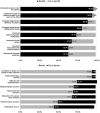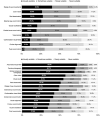Tele-Neuro-Ophthalmology Utilization, Availability, and Attitudes: Update 1 Year Into the COVID-19 Public Health Emergency
- PMID: 36166781
- PMCID: PMC9924738
- DOI: 10.1097/WNO.0000000000001663
Tele-Neuro-Ophthalmology Utilization, Availability, and Attitudes: Update 1 Year Into the COVID-19 Public Health Emergency
Abstract
Background: Telehealth was rapidly adopted early in the COVID-19 pandemic as a way to provide medical care while reducing risk of SARS-CoV2 transmission. Since then, telehealth utilization has evolved differentially according to subspecialty. This study assessed changes in neuro-ophthalmology during the first year of the COVID-19 pandemic.
Methods: Telehealth utilization and opinions pre-COVID-19, early pandemic (spring 2020), and 1 year later (spring 2021) were surveyed among practicing neuro-ophthalmologists in and outside the United States using an online platform. Demographics, self-reported utilization, perceived benefits, barriers, and examination suitability were collected over a 2-week period in May 2021.
Results: A total of 135 practicing neuro-ophthalmologists (81.5% United States, 47.4% females, median age 45-54 years) completed the survey. The proportion of participants using video visits remained elevated during COVID + 1 year (50.8%) compared with pre-COVID (6%, P < 0.0005, McNemar), although decreased compared with early COVID (67%, P < 0.0005). Video visits were the most commonly used methodology. The proportion of participants using remote testing (42.2% vs 46.2%), virtual second opinions (14.5% vs 11.9%, P = 0.45), and eConsults (13.5% vs 16.2%, P = 0.38) remained similar between early and COVID + 1 year ( P = 0.25). The majority selected increased access to care, better continuity of care, and enhanced patient appointment efficiency as benefits, whereas reimbursement, liability, disruption of in-person clinic flow, limitations of video examinations, and patient technology use were barriers. Many participants deemed many neuro-ophthalmic examination elements unsuitable when collected during a live video session, although participants believed some examination components could be evaluated adequately through a review of ancillary testing or outside records.
Conclusions: One year into the COVID-19 pandemic, neuro-ophthalmologists maintained telemedicine utilization at rates higher than prepandemic levels. Tele-neuro-ophthalmology remains a valuable tool in augmenting patient care.
Copyright © 2022 by North American Neuro-Ophthalmology Society.
Conflict of interest statement
The authors report no conflicts of interest.
Figures




References
-
- Centers for Medicare and Medicaid Services. Medicare Telehealth Frequently Asked Questions (FAQs). Available at: https://edit.cms.gov/files/document/medicare-telehealth-frequently-asked.... Accessed June 9, 2022.
-
- American Association of Family Physicians. Major Insurers Changing Telehealth Billing Requirement in 2022. Available at: https://www.aafp.org/journals/fpm/blogs/gettingpaid/entry/telehealth_pos.... Accessed June 9, 2022.
Publication types
MeSH terms
Substances
Grants and funding
LinkOut - more resources
Full Text Sources
Medical
Miscellaneous

